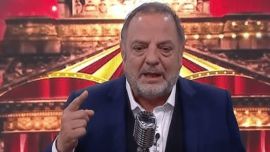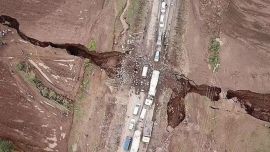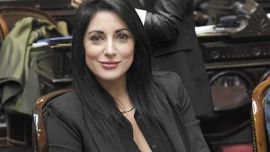The CGT umbrella labour confederation marked its 90th anniversary in understated and unified fashion on Sunday – and not only because of restrictions put in place to tackle the coronavirus pandemic.
With the heavyweight union grouping’s elections postponed until next year due to the pandemic, traditional differences between moderate and militant wings were shelved, with Argentina in the midst of a tough economic and job crisis stemming from Covid-19.
In a statement commemorating its anniversary, the CGT paid tribute to “the tireless struggle of great leaders who have given up their lives in defence of the innumerable conquests of the working people.”
The group's leadership called for “a strong and united CGT with economic independence and political sovereignty as the north and social justice as the flag."
Several government officials, including Cabinet Chief Santiago Cafiero and Labour Minister Claudio Moroni, also celebrated the anniversary in posts on social networks.
As it celebrates nine decades of existence, 2020 finds the CGT without a leadership to contain its plentiful sectors and their complaints amid the severe economic and job crisis of the coronavirus pandemic, as well as the growing challenge of social organisations representing the informally employed.
Here’s a look at the controversial union grouping, which continues to play a large role in labour relations in today’s Argentina.
Foundations
Argentina’s main trade union confederation was founded on September 27, 1930, just three weeks after a military coup altering the course of Argentine history and in the first year of a worldwide depression when the country was starting to industrialise via import substitution. Its first general strike took place in 1936.
The result of an agreement between socialist, Communist and independent trade union leaders, it was the ideology of the former which prevailed in the early days until the emergence of Juan Domingo Perón. His policies of benefits for workers as the military junta’s labour minister turned the labour movement Peronist, confirmed as from the historic date of October 17, 1945, when the CGT called a general strike and joined the gigantic demonstrations calling for their leader’s release from imprisonment on Isla Martín García.
It was before the rise of Perón, in 1943, that the CGT underwent the first of its many divisions, splitting into two splinters headed by José Domenech and Francisco Pérez Leirós, both socialists.
But as from 1945 the CGT converted itself into the "spine" of the Peronist movement, although it was not exempt from all the ideological variations and contradictions of that doctrine – its leaders identified with both the left and the right.
After the fall of Perón in 1955, union activity was banned by the military government and the CGT placed itself at the head of the resistance movement seeking the return of the exiled Justicialist leader, a process which eventually took 18 years.
Those years of political violence, with clashes between leftist and right-wing Peronists, included the 1973 assassination of CGT secretary-general José Ignacio Rucci, a crime attributed to the Montonero guerrillas.
Following the death of Perón in 1974 the military coup of March 1976 again banned organised labour, placing trade unions under trusteeship and arresting many of their leaders.
In 1979, in the midst of the dictatorship, a group of union leaders (including Saúl Ubaldini) headed the first protests against the military regime. The next year they revived the CGT, despite the official ban, as the CGT-Brasil, which on November 7, 1981 headed the first mass demonstration against the dictatorship, while a less confrontational group of union leaders set up the CGT-Azopardo in the historic headquarters in that street (just three blocks down the road from the then-offices of the Buenos Aires Herald).
Into democracy
Following the military régime’s defeat in the Malvinas, the return of democracy became inevitable.
Headed by UOM metal workers leader Lorenzo Miguel, the CGT played a prime role in making Ítalo Luder the Peronist candidate for the 1983 elections. Radical leader Raúl Alfonsín, however, would go on to win the race for the Casa Rosada.
The CGT reacted to that defeat by calling 13 general strikes against the Alfonsín government, but in those years the Renewal Peronists took over the movement, giving it a more political leadership which shut the trade union sector out of decision-making and ended long years of trade unionists claiming a majority of Peronist seats in Congress.
The political alignment of new Peronist president Carlos Menem with the Washington Consensus as from 1989 triggered new splinters in the CGT – the CTA and the MTA (respectively the Confederación de and Movimiento de los Trabajadores Argentinos), with the former led by state employee Víctor de Gennaro and teacher Hugo Yasky and the latter by teamster Hugo Moyano, a figure who would rise to increasing prominence.
In the following decade, Moyano came to head a reunified CGT supporting the policies of the Néstor Kirchner presidency (2003-2007). This too eventually led to a new splinter, the CGT Azul y Blanca under Luis Barrionuevo (restaurant workers). A more important rift developed later, when Moyano parted company with Cristina Fernández de Kirchner at the start of her second term (2011), prompting the creation of a pro-government CGT-Alsina under Antonio Caló of the UOM metal workers.
While the CGT remained united during the Mauricio Macri presidency (2015-9), the tussles between moderates and hardliners continued and some sectors shunned the leadership.
That leads us to today: the mandate of current CGT secretaries-general Héctor Daer and Carlos Acuña expired last August but the pandemic has caused the elections to be postponed until next year. Teamster Pablo Moyano, the son of Hugo, fancies his chances.
IN FOCUS: A man’s world
The CGT has always been very much a man’s world with health workers’ representative Susana Stochero de Rueda the only female trade unionist ever to rise briefly to the rank of secretary-general (2004-2005) - even then as part of a triumvirate in tandem with teamster boss Hugo Moyano and José Luis Lingeri, heading waterworks employees.
Interviewed by Noticias Argentinas this week, Stochero de Rueda complained that her proposals were consistently ignored by colleagues who were "unaccustomed to negotiating with a woman … due to machismo."
Nevertheless, Stochero remains optimistic for the future. She believes that Argentina’s " feminist movement is achieving concrete conquests" and argues that today’s labour leadership needs to be updated in general to represent wider society.
Despite the progress, the Santa Fe trade unionist finds it "very sad" that today there is only one woman on the CGT’s executive board (Noé Ruiz, representing fashion workers) while back in 2004-2005 she was one of five. Nevertheless, she feels that this would improve if the CGT’s leadership expanded and came to incorporate all unions and sectors.
IN FOCUS: CGT leadership
CGT secretaries-general during its 90 years of existence
1930-1936 – Luis Cerutti (Unión Ferroviaria railwaymen)
1936-1942 – José Domenech (UF)
1942-1943 – José Domenech (CGT1); Francisco Pérez Leirós of the municipal workers (CGT2)
1943-1944 – Ramón Seijas (UTA transport workers)
1944-1945 – Alcides Montiel (brewers)
1945-1946 – Silverio Pontieri (UF)
1946-1947 – Luis Gay (FOET telephone workers)
1947-1952 – José Espejo (food workers)
1952-1955 – Eduardo Vuletich (pharmaceutical workers)
1955 – Andrés Framini (textile workers); Luis Natalini (Luz y Fuerza electricity workers); Dante Viel (UPCN civil servants)
1955-1958 – Military trusteeship
1958-1963 – Multiple collegiate leadership
1963-1965 – José Alonso (garment workers)
1965-1966 – Fernando Donaires (paper workers)
1966-1968 – Francisco Prado (Luz y Fuerza)
1968-1972 – Vicente Roqué (CGT-Azopardo) flour workers; Raimundo Ongaro (CGT-Argentinos) printers
1973 – José Ignacio Rucci (UOM metal workers)
1973-1974 – Adelino Romero (textile workers)
1974 – Raúl Ravitti (UF)
1974-1975 – Segundo Bienvenido Palma (UOCRA building workers)
1975-1976 – Casildo Herrera (textile workers)
1976-1980 – Dissolved by the military dictatorship
1980-1989 – Saúl Ubaldini (brewers)
1989-1992 – Saúl Ubaldini (CGT-Azopardo); – Guerino Andreoni (CGT-San Martín) FAECYS shop employees
1992-1993 – Oscar Lescano (Luz y Fuerza); – José Rodríguez (SMATA auto workers); José Pedraza (UF); Aníbal Martínez (UOM); Ramón Baldassini (postal workers)
1993-1994 – Naldo Brunelli (UOM)
1994-1995 – Antonio Cassia (oil workers)
1995-1996 – Gerardo Martínez (UOCRA)
1996-2000 – Rodolfo Daer (food workers)
2000-2002 – Rodolfo Daer (official CGT); Hugo Moyano (dissident CGT) teamsters
2002-2003 – Hugo Moyano; Susana Rueda (health workers); José Luis Lingieri (Obras Sanitarias waterworks employees)
2003-2008 – Hugo Moyano
2008-2012 – Hugo Moyano; Luis Barrionuevo (CGT Azul y Blanca) restaurant workers
2012-2016 – Hugo Moyano (CGT-Azopardo); Antonio Caló (CGT-Alsina) UOM; Luis Barrionuevo (CGT Azul y Blanca)
2016-2020 – Héctor Daer (health workers); Carlos Acuña (service station employees); Juan Carlos Schmid (resigned in 2018) dredging and buoy-laying
– TIMES/PERFIL/NA


















Comments